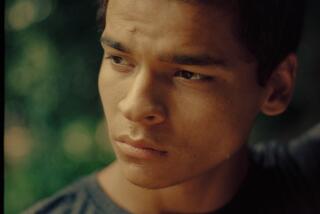TV REVIEW : ‘Standing Bear’: High Drama of History
- Share via
After the fireworks tonight, is anyone going to be in the mood for a more serious look at what the Fourth of July is all about?
Probably not. All the same, “The Trial of Standing Bear” (Channels 28 and 15 at 9:30 p.m.) is an appropriate way to mark the holiday. While this enterprising docudrama is not about what happened in 1776, it does demonstrate how the spirit of 1776 has expanded over the years, often at considerable cost to those who do the expanding.
The late hour and slow start of the show may cause some viewers to turn it off. The beginning is rather ponderous, as William Shatner starts to narrate a tale about a band of Ponca Indians whose lands in northern Nebraska were confiscated by the government in 1868. Although we’re watching Indian actors in all of the Indian roles, the initial scenes look too much like animated museum dioramas.
We learn that the Poncas were forced to resettle in the Indian Territory, 500 miles to the south, where government neglect soon began to decimate the tribe. A band of 30 Poncas, led by Standing Bear, vowed to return home, but before they could reach their ancestral homeland, they were intercepted by the Army near Omaha.
Held as prisoners and about to be sent back to Indian Territory, the Poncas attracted the attention of a reporter and two attorneys who took their case to court. In the resulting trial, a federal judge extended the concept of personhood to Indians for the first time.
However, there was a price to pay. In order to prove that they were deserving of constitutional protection, the Poncas had to establish that they were not “foreigners,” or members of a sovereign tribe, but were determined to live as whites.
It’s this development that turns the story from a simple celebration of American jurisprudence into something more penetrating.
As the issues become thornier, the script--based on the 1880 book “The Ponca Chiefs,” by Thomas Tibbles (the reporter who came to the aid of the Poncas)--becomes much more assured. The narration disappears, and we’re caught up in a courtroom drama that’s as spellbinding as anything on “L.A. Law.”
The film (which also screens Friday at 9 p.m. on Channel 24) is anchored by a trio of formidable performances. Ivan Naranjo’s Standing Bear is a majestic, charismatic creation. Even as he denies that he is still the chief of his tribe, he wears Indian garb that unmistakably signals the opposite. Naranjo begins his performance quietly, then slowly turns up the volume. His final courtroom speech is thunderous.
His opponent, at least on paper, is George Riddle as the local Army commander, a contrary old cuss who actually hopes the judge will release him from his orders to send the Poncas back to Indian Territory. Employing the stoniest of silences, Riddle speaks volumes.
George Ede plays the senior attorney on the Poncas’ side. It appears that he easily could inherit the roles that belonged to the late John Houseman.
Marshall Jamison directed for University of Nebraska-Lincoln Television/the Nebraska ETV Network. The program is a model of the work that a “regional” public television station can do--taking an important but little-known chapter of local history and making high drama of it, in a way that should interest all Americans.
This also is an example of the kind of film that is supposed to win the Humanitas Prize for TV writing that enriches the human spirit. This year’s Humanitas judges couldn’t find a movie on the commercial networks that merited the honor. Perhaps they should include public television in next year’s competition.
More to Read
The complete guide to home viewing
Get Screen Gab for everything about the TV shows and streaming movies everyone’s talking about.
You may occasionally receive promotional content from the Los Angeles Times.






